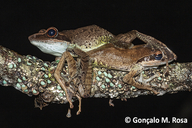|
Guibemantis diphonus Vences, Jovanovic, Safarek, Glaw & Köhler, 2015
| family: Mantellidae subfamily: Mantellinae genus: Guibemantis |
| Species Description: Vences M, Jovanovic O, Safarek G, Glaw F, Koehler J. 2015 A new arboreal frog of the genus Guibemantis from the southeast of Madagascar (Anura: Mantellidae). Zootaxa 4059: 569-580. | |
 © 2021 Gonçalo M. Rosa (1 of 1) |
|
|
Country distribution from AmphibiaWeb's database: Madagascar
|
|



 Map of Life
Map of Life